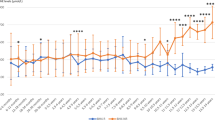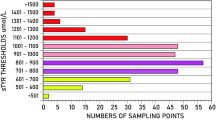Abstract
Background:
Only limited data are available on the blood phenylalanine (Phe) concentrations achieved in European patients with phenylketonuria (PKU) on a low-Phe diet.
Objective:
A survey was conducted to compare blood Phe control achieved in diet-treated patients with PKU of different age groups in 10 European centres.
Methods:
Centres experienced in the management of PKU from Belgium, Denmark, Germany, Italy, The Netherlands, Norway, Poland, Spain, Turkey and the United Kingdom provided retrospective audit data of all patients with PKU treated by diet over a 1-year period. Standard questions were used to collect median data on blood Phe concentrations, percentage of blood Phe concentrations below upper target reference ranges and frequency of blood Phe sampling.
Results:
Data from 1921 patients on dietary management were included. Blood Phe concentrations were well controlled and comparable across centres in the early years of life. The percentages of blood Phe concentrations meeting each centre's local and national target ranges were 88% in children aged up to 1 year, 74% for 1–10 years, 89% for 11–16 years and 65% for adults (>16 years). The frequency of home blood sampling, compared with local and national recommendations for monitoring Phe concentrations, appeared to decline with age (from approximately 100% in infancy to 83% in teenagers and 55% in adults).
Conclusions:
Although blood Phe control generally deteriorated with age, some improvement was observed in adolescent years across the 10 European centres. The blood Phe control achieved seemed comparable in many of the European centres irrespective of different dietary treatments or national policies.
This is a preview of subscription content, access via your institution
Access options
Subscribe to this journal
Receive 12 print issues and online access
$259.00 per year
only $21.58 per issue
Buy this article
- Purchase on Springer Link
- Instant access to full article PDF
Prices may be subject to local taxes which are calculated during checkout
Similar content being viewed by others
References
Ahring K, Belanger-Quintana A, Dokoupil K, Gokmen Ozel H, Lammardo AM, MacDonald A et al. (2009). Dietary management practices in phenylketonuria across European centres. Clin Nutr 28, 231–236.
Gokmen Ozel H, Kucukkasap T, Koksal G, Kalkanoglu Sivri HS, Dursun A, Tokatli A et al. (2008). Does maternal knowledge impact blood phenylalanine concentration in Turkish children with phenylketonuria? J Inherit Metab Dis, published online 27 June 2008; doi:10.1007/s10545-10008-10775-10543.
MacDonald A, Lilburn M, Davies P, Evans S, Daly A, Hall SK et al. (2006). ‘Ready to drink’ protein substitute is easier is for people with phenylketonuria. J Inherit Metab Dis 29, 526–531.
Meli C, Bianca S (2002). Dietary control of phenylketonuria. Lancet 360, 2075–2076.
Mundy H, Lilburn M, Cousins A, Lee P (2002). Dietary control of phenylketonuria. Lancet 360, 2076.
Walter JH, White FJ (2004). Blood phenylalanine control in adolescents with phenylketonuria. Int J Adolesc Med Health 16, 41–45.
Walter JH, White FJ, Hall SK, MacDonald A, Rylance G, Boneh A et al. (2002). How practical are recommendations for dietary control in phenylketonuria? Lancet 360, 55–57.
Acknowledgements
We thank all members of the PKU treatment teams at their centres. We are also grateful to Dr Regina Ensenauer (Department of Metabolism and Nutrition, Dr von Hauner Children's Hospital, University of Munich, Germany) for a critical review of this manuscript. We acknowledge the contributions of physicians from the following countries: Belgium: Dr Philippe Goyens and Dr Corinne De Laet; Denmark: Dr Jytte Bieber Nielsen; Italy: Dr.ssa Elisabetta Salvatici; Norway: Dr Jens V Jorgensen and Dr Per Mathisen; The Netherlands: Dr Francjan. J van Spronsen; and Turkey: Professor Dr Turgay Co°kun. Data were used with permission of the responsible physicians. This study was sponsored by an unrestricted educational grant from Merck Serono SA—Geneva, Switzerland. We acknowledge editorial assistance provided by Dr Mike Gwilt (GT Communications, supported by Merck Serono SA—Geneva, Switzerland) and Dr Christina Herden (Physicians World Europe GmbH, supported by Merck Serono SA—Geneva, Switzerland).
Author information
Authors and Affiliations
Corresponding author
Ethics declarations
Competing interests
Kirsten Ahring has received compensation from Merck Serono as a member of the European Nutritionist Expert Panel in PKU.
Amaya Bélanger-Quintana has received compensation from Merck Serono as a member of the European Nutritionist Expert Panel in PKU and the Scientific Advisory Board on PKU.
Katharina Dokoupil has received compensation from Merck Serono as a member of the European Nutritionist Expert Panel in PKU.
Hulya Gokmen-Ozel has received compensation from Merck Serono as a member of the European Nutritionist Expert Panel in PKU.
Anna Maria Lammardo has received compensation from Merck Serono as a member of the European Nutritionist Expert Panel in PKU.
Anita MacDonald has received compensation from Merck Serono as a member of the European Nutritionist Expert Panel in PKU and as a member of the Scientific Advisory Board on PKU. She has received honoraria for consulting or lecturing from SHS International, Nutricia and Merck Serono. She has received research grant funding from Vitaflo International, Nutricia and SHS International.
Kristina Motzfeldt has received compensation from Merck Serono as a member of the European Nutritionist Expert Panel in PKU. She has received honoraria for consulting or lecturing from SHS International and Vitaflo Scandinavia.
Maria Nowacka has received compensation from Merck Serono as a member of the European Nutritionist Expert Panel in PKU.
Martine Robert has received compensation from Merck Serono as a member of the European Nutritionist Expert Panel in PKU.
Margreet van Rijn has received compensation from Merck Serono as a member of the European Nutritionist Expert Panel in PKU. She has received honoraria for consulting or lecturing from Milupa, Nutricia and Orphan Europe. She has received research grant funding from SHS International, Milupa, Metakids and Vitaflo International.
Additional information
Supplementary Information accompanies the paper on European Journal of Clinical Nutrition website
Supplementary information
Rights and permissions
About this article
Cite this article
Ahring, K., Bélanger-Quintana, A., Dokoupil, K. et al. Blood phenylalanine control in phenylketonuria: a survey of 10 European centres. Eur J Clin Nutr 65, 275–278 (2011). https://doi.org/10.1038/ejcn.2010.258
Received:
Revised:
Accepted:
Published:
Issue Date:
DOI: https://doi.org/10.1038/ejcn.2010.258
Keywords
This article is cited by
-
Measuring Burden of Illness in Phenylketonuria (PKU): Development of the PKU Symptom Severity and Impacts Scale as a Robust Patient-Reported Outcome
Advances in Therapy (2022)
-
Blood phenylalanine reduction reverses gene expression changes observed in a mouse model of phenylketonuria
Scientific Reports (2021)
-
Development of an inventory to assess perceived barriers related to PKU treatment
Journal of Patient-Reported Outcomes (2020)
-
Maternal phenylketonuria in Turkey: outcomes of 71 pregnancies and issues in management
European Journal of Pediatrics (2019)
-
Dietary patterns, cost and compliance with low-protein diet of phenylketonuria and other inherited metabolic diseases
European Journal of Clinical Nutrition (2018)



